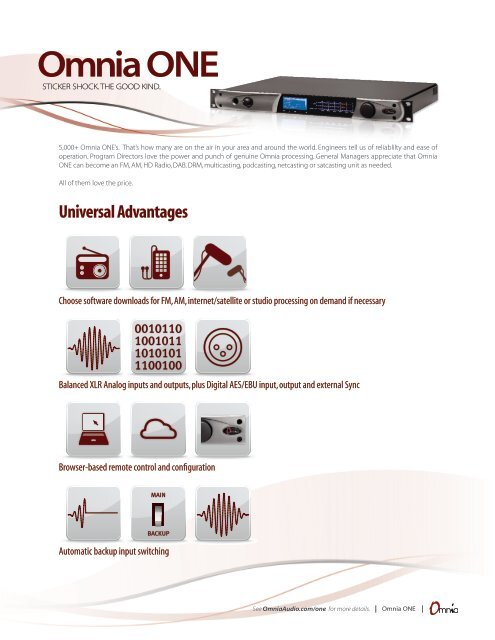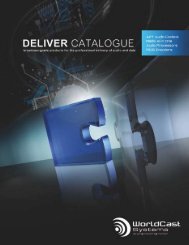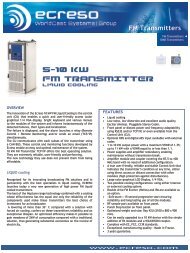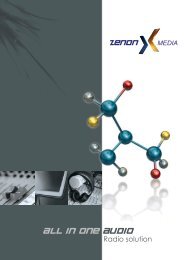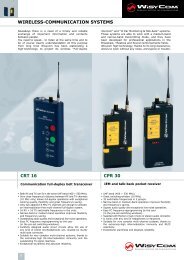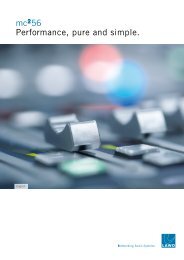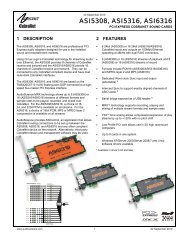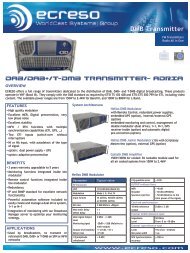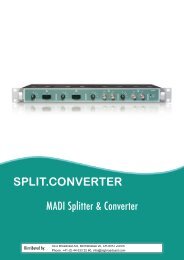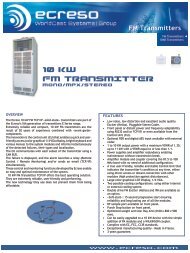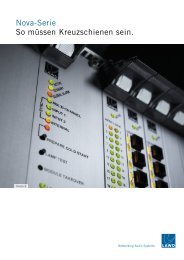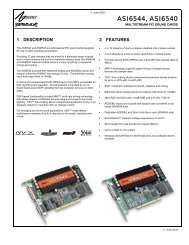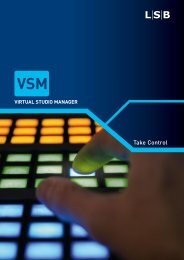Omnia ONE Brochure - Web Quality - Omnia Audio
Omnia ONE Brochure - Web Quality - Omnia Audio
Omnia ONE Brochure - Web Quality - Omnia Audio
Create successful ePaper yourself
Turn your PDF publications into a flip-book with our unique Google optimized e-Paper software.
<strong>Omnia</strong> <strong>ONE</strong><br />
STICKER SHOCK. THE GOOD KIND.<br />
See <strong>Omnia</strong><strong>Audio</strong>.com/one for more details.<br />
| <strong>Omnia</strong> <strong>ONE</strong> |<br />
OMNIA<strong>ONE</strong> | 1<br />
5,000+ <strong>Omnia</strong> <strong>ONE</strong>’s. That’s how many are on the air in your area and around the world. Engineers tell us of reliablilty and ease of<br />
operation. Program Directors love the power and punch of genuine <strong>Omnia</strong> processing. General Managers appreciate that <strong>Omnia</strong><br />
<strong>ONE</strong> can become an FM, AM, HD Radio, DAB. DRM, multicasting, podcasting, netcasting or satcasting unit as needed.<br />
All of them love the price.<br />
Universal Advantages<br />
Choose software downloads for FM, AM, internet/satellite or studio processing on demand if necessary<br />
0010110<br />
1001011<br />
1010101<br />
1100100<br />
Balanced XLR Analog inputs and outputs, plus Digital AES/EBU input, output and external Sync<br />
Browser-based remote control and configuration<br />
MAIN<br />
BACKUP<br />
Automatic backup input switching
2 | OMNIA<strong>ONE</strong><br />
Universal Advantages (Cont.)<br />
Livewire / Ethernet RJ45 jack<br />
Universal Power Input<br />
Robust headphone amp with rugged jack and front panel volume control<br />
Single Jog-Wheel and Selection Button user interface with LED level metering and LCD screen<br />
FM Advantages:<br />
Smart wideband AGC followed by advanced Four-Band AGC and selectable Four or Five-Band Peak Limiter sections. <strong>Omnia</strong>’s<br />
advanced, fully distortion-controlled, pre-emphasized final limiter / clipper. A newly designed digital stereo generator with SCA<br />
convenience input, two independently adjustable composite MPX outputs and 19kHz pilot output for synchronization to external<br />
RDS generators.<br />
AM Advantages:<br />
<strong>Omnia</strong>’s advanced NRSC compliant, distortion-managed final limiter / clipper, including selectable Low Pass Filter frequencies<br />
that support AM HD transmission installations...the same as used in the <strong>Omnia</strong> <strong>ONE</strong>’s bigger siblings.<br />
<strong>Omnia</strong> <strong>ONE</strong> Multicast Advantages<br />
Features SENSUS, an audio conditioning technology to minimize codec artifacts as well as restore the fullness and depth that<br />
bit-reduction steals. See expanded explanation about SENSUS technology later in this brochure. Ultra low-distortion final limiting<br />
optimized for the HD codec.<br />
<strong>Omnia</strong> Studio Pro Advantages:<br />
Full-bandwidth processor for applications that require minimal delay and do not require absolute peak limiting.<br />
The first studio processor to include a four-band compressor / limiter allowing you precise and accurately defined control while<br />
pre-processing music, commercials, remote feeds, or sweetening audio. Applications include recording studios, mastering labs, TV<br />
stations, radio headphone feeds ... just abut any application where signal processing is needed.<br />
| <strong>Omnia</strong> <strong>ONE</strong> | See <strong>Omnia</strong><strong>Audio</strong>.com/one for more details.
<strong>Omnia</strong> <strong>ONE</strong> Overview<br />
HEADPH<strong>ONE</strong> JACK JOG WHEEL AND SELECTION BUTTON<br />
HEADPH<strong>ONE</strong> LEVEL CONTROL<br />
MAIN MENU / G/R METERING LCD DISPLAY<br />
<strong>Omnia</strong> <strong>ONE</strong> Physical Specifications<br />
Dimensions:<br />
h 19” wide x 1.7” high x 12” deep (48 cm wide x 4.5 cm high x 30<br />
cm deep). Unit requires one EIA rack spaces for mounting.<br />
h Allow up to 4” in rear for connector and cable clearence.<br />
h 6 lbs. unit weight<br />
Shipping Weight:<br />
h 12 lbs. / 5.5 kg<br />
Accessories:<br />
h <strong>Omnia</strong> <strong>ONE</strong> Manual<br />
h <strong>Omnia</strong> <strong>ONE</strong> Quick Start Guide<br />
h Warranty Registraton<br />
h 120V AC power cord<br />
h 240V AC (Euro power cord)<br />
h Rack screws (bag of five)<br />
1.7”<br />
(4.5 cm)<br />
<strong>Omnia</strong> <strong>ONE</strong> Back Panel<br />
19”<br />
(48 cm)<br />
LEVEL METERS<br />
See <strong>Omnia</strong><strong>Audio</strong>.com/one for more details.<br />
12”<br />
(30 cm)<br />
| <strong>Omnia</strong> <strong>ONE</strong> |<br />
OMNIA<strong>ONE</strong> | 3
4 | OMNIA<strong>ONE</strong><br />
<strong>Omnia</strong> <strong>ONE</strong> Performance Specifications<br />
<strong>Omnia</strong> <strong>ONE</strong> FM Specs.<br />
Frequency Response:<br />
h Complies with the standard 50 or 75 microsecond pre-emphasis<br />
curve within ± 0.50 dB, 30 Hz to 15 kHz. The analog left/right<br />
outputs and AES/EBU Digital outputs can be configured for flat<br />
or pre-emphasized output..<br />
System Distortion:<br />
h Less than 0.01% THD, 20 Hz – 7.5 kHz. Second harmonic distortion<br />
above 7.5 kHz is not audible in the FM system.<br />
h*Signal-NoiseRatio: > -80 dB de-emphasized, 20 Hz –- 15 kHz<br />
bandwidth, referenced to 100% modulation).<br />
*The measured noise floor will depend upon the settings of<br />
the Input and Output Gain controls and is primarily governed<br />
by dynamic range of the Crystal Semiconductor CS5361 A/D<br />
Converter which is specified as >110 dB. The dynamic range of<br />
the internal digital signal processing chain is >144 dB.<br />
Stereo Separation:<br />
h Greater than 65 dB, 20 Hz –- 15 kHz; 70 dB typical.<br />
Crosstalk:<br />
h > -70 dB, 20 Hz -- 15 kHz.<br />
Composite Outputs:<br />
h SourceImpedance: 5 ohms or 75 ohms, jumper-selectable. Singleended<br />
and floating over chassis ground.<br />
h OutputLevel: 0V to 10V in 0.05V steps, software adjustable.<br />
h D/AConversion: Texas Instruments/Burr Brown PCM1798, 24-bit<br />
sigmadelta converter.<br />
h Configuration: Two electrically independent outputs. Software<br />
based level adjustment.<br />
h Load Impedance: 50 ohms or greater load is suggested.<br />
h PilotLevel: Adjustable from 4.0% to 12.0% in 0.1% steps and OFF.<br />
h PilotStability: 19 kHz, ± 0.5 Hz.<br />
h Signal-to-NoiseRatio: -85 dB typical, 75 μS de-emphasized, 15 kHz<br />
bandwidth, referenced to 100% modulation).<br />
h Distortion: < 0.02% THD 20 Hz – 15 kHz bandwidth, 75 μS<br />
deemphasized, referenced to 100% modulation.<br />
h StereoSeparation: > 65 dB, 30 Hz – 15 kHz.<br />
h LinearCrosstalk: > -80 dB, main to sub or sub to main channel<br />
(referenced to 100% modulation).<br />
| <strong>Omnia</strong> <strong>ONE</strong> | See <strong>Omnia</strong><strong>Audio</strong>.com/one for more details.<br />
h Non-linearCrosstalk: > -80 dB, main to sub or sub to main channel<br />
(referenced to 100% modulation).<br />
h 38kHzSuppression: > 70 dB (referenced to 100% modulation).<br />
h 76kHzSuppression: > 80 dB (referenced to 100% modulation).<br />
h PilotProtection: > -65 dB relative to 9% pilot injection, ± 1 kHz.<br />
h 57kHz(RDS/RBDS) Protection: better than -50 dB.<br />
h Connectors: Two EMI suppressed female BNC, floating over<br />
chassis ground.<br />
h MaximumLoadCapacitance: 5nF (at 10 ohms source impedance).<br />
h Maximumcablelength: 100 feet/30 meters RG-58A/U.<br />
Analog <strong>Audio</strong> Input:<br />
h Left/Right Stereo.<br />
h Electronically balanced.<br />
h Input impedance 10k ohms resistive.<br />
h MaximumInputLevel: +22 dBu.<br />
h Nominal InputLevel: +4dBu, which nets a -18dBFS input meter<br />
reading on a steady-state signal when the Input Gain control<br />
is set to 0.0dB. Program material with a nominal average level<br />
(VU reading) of +4dBu will typically produce peak readings on<br />
the input meter in the range of -12 dBFS to -6dBFS. This is the<br />
correct operating level.<br />
h A/DConversion: Crystal Semiconductor CS5361, 24 bit 128x oversampled<br />
delta sigma converter with linear-phase anti-aliasing<br />
filter. Pre-ADC anti-alias filter, with high-pass filter at
<strong>Omnia</strong> <strong>ONE</strong> Performance Specifications (Cont.)<br />
Digital <strong>Audio</strong> Input:<br />
h Configuration: Stereo per AES/EBU standard, CS8420 Digital <strong>Audio</strong><br />
Transceiver with 24 bit resolution, software selection of stereo,<br />
mono from left, mono from right or mono from sum. Automatically<br />
accepts and locks to input sample rates between 32 and<br />
108 kHz.<br />
h Connector: EMI-suppressed RJ-45 female pinned according to<br />
StudioHub+® standards. Transformer isolated, balanced, and<br />
floating according to AES3 standard.<br />
Digital <strong>Audio</strong> Output:<br />
h Stereo per AES3 standard. Digital Output sample rate can lock<br />
to the input, lock to an additional external sync source, or use<br />
the internal 48kHz rate.<br />
h Connector: EMI-suppressed RJ-45 female according to Studio-<br />
Hub+® standards. Transformer isolated, balanced, and floating<br />
according to AES3 standard.<br />
Digital Output Level:<br />
h-24.0 to 0.0 dBFS peak, software adjustable in 0.1dB steps.<br />
External Sync Input:<br />
h External Sync: Allows the output sample rate to be synchronized<br />
to an AES3 signal applied to the Ext. Sync input connector.<br />
(Does not accept Word Clock inputs)<br />
h Connector: EMI-suppressed RJ-45 female according to Studio-<br />
Hub+® standards. Transformer isolated, balanced, and floating<br />
according to AES3 standard.<br />
External Sync Range:<br />
h Automatically accepts sample rates between 32kHz and 96kHz.<br />
h Connector: EMI-suppressed RJ-45 female pinned according to<br />
StudioHub+® standards, Transformer isolated, balanced, and<br />
floating according to AES3 standard.<br />
Remote Control Methods:<br />
h External Modem or 10/100BaseTX Ethernet.<br />
h--Modem(supportnotyetavailableasof softwareversion2.2): Usersupplied<br />
Hayes command compatible external serial modem<br />
connected to rear-panel DB-9 male serial port.<br />
h--Ethernet: TCP/IP control via web page interface and Java<br />
(TM) remote control program included in the web pages. All<br />
software is served from the built-in web server; there is nothing<br />
to install on the user’s computer.<br />
h PortsUsed: The defaults are TCP Ports 4545 and 4546 (for control<br />
and metering data, respectively).<br />
See <strong>Omnia</strong><strong>Audio</strong>.com/one for more details.<br />
| <strong>Omnia</strong> <strong>ONE</strong> |<br />
OMNIA<strong>ONE</strong> | 5<br />
h Connectors: Modem port - EMI-suppressed DB-9 male connector.<br />
Ethernet - Industry standard EMI-suppressed RJ-45 connector.<br />
GPI Interface:<br />
h Support not yet available as of software version 2.2.<br />
h Connector: EMI suppressed DB-9 female connector.<br />
Power Requirements:<br />
h Voltage: 100-250 VAC, 47-63 Hz., Less than 40 VA.<br />
h PowerConnector: EMI suppressed IEC male. Detachable 3-wire<br />
power cords supplied for US and European use.<br />
h PowerSupply: Internal. Overvoltage and short circuit protected.<br />
Meets EN55022, EN55011 Level B Conducted Emissions.<br />
EN61000-4-2, -3, -4, -5, -6 level 3 immunity compliant. Full<br />
international safety approval. CE marked.<br />
h Environmental: Operating Temperature: 32 to 122 deg. F / 0 to<br />
50 deg. C for all operating voltage ranges. Humidity: 0-95% RH,<br />
non-condensing.<br />
<strong>Omnia</strong> <strong>ONE</strong> AM Specs.<br />
Note:<br />
h Discrete I/O measurements have been made in “Bypass” mode<br />
(available in the Input/Output menu).<br />
Note:<br />
h All measurements made with the supplied “FACT_TEST” preset,<br />
which is available in the Preset Submenu.<br />
System Frequency Response:<br />
h Complies with the NRSC emphasis curve within ± 0.50 dB, 30 Hz<br />
to 10 kHz. (At a setting of “10” on the HF EQ control)<br />
System *Signal to Noise Ratio:<br />
h-80 dB de-emphasized, 20 Hz –- 10 kHz NRSC bandwidth,<br />
referenced to 100% modulation).<br />
*The measured noise floor will depend upon the settings of<br />
the Input and Output Gain controls and is primarily governed<br />
by dynamic range of the Crystal Semiconductor CS5361 A/D<br />
Converter which is specified as >110 dB. The dynamic range of<br />
the internal digital signal processing chain is >144 dB.<br />
System Distortion<br />
h Less than 0.01% THD, 20 Hz – 5 kHz. (second order harmonic<br />
distortion above 5 kHz is not relevant in the AM system due to<br />
the removal of harmonics by the system’s 10 kHz low pass filter)
6 | OMNIA<strong>ONE</strong><br />
<strong>Omnia</strong> <strong>ONE</strong> Performance Specifications (Cont.)<br />
System Stereo Separation<br />
h Greater than 65 dB, 20 Hz –- 10 kHz; greater than 70 dB typical.<br />
Analog <strong>Audio</strong> Input:<br />
h Left/Right Stereo.<br />
h Electronically balanced.<br />
h Input impedance 10k ohms resistive.<br />
h MaximumInputLevel: +22 dBu.<br />
h Nominal InputLevel: +4dBu, which nets a -18dBFS input meter<br />
reading on a steady-state signal when the Input Gain control<br />
is set to 0.0dB. Program material with a nominal average level<br />
(VU reading) of +4dBu will typically produce peak readings on<br />
the input meter in the range of -12 dBFS to -6dBFS. This is the<br />
correct operating level.<br />
A/D Conversion:<br />
h Crystal Semiconductor CS5361, 24 bit 128x over-sampled delta<br />
sigma converter with linear-phase anti-aliasing filter. Pre-ADC<br />
anti-alias filter, with high-pass filter at
<strong>Omnia</strong> <strong>ONE</strong> Performance Specifications (Cont.)<br />
h PowerConnector: EMI suppressed IEC male.<br />
Detachable 3-wire power cords supplied for US and European use.<br />
h PowerSupply: Internal. Overvoltage and short circuit protected.<br />
Meets EN55022, EN55011 Level B Conducted Emissions.<br />
EN61000-4-2, -3, -4, -5, -6 level 3 immunity compliant. Full<br />
international safety approval. CE marked.<br />
Environmental:<br />
h OperatingTemperature: 32 to 122 deg. F / 0 to 50 deg. C for all<br />
operating voltage ranges. Humidity: 0-95% RH, non-condensing.<br />
<strong>Omnia</strong> <strong>ONE</strong> Multicast/DAB<br />
& Studio Pro Specs.<br />
Note:<br />
h All measurements made using “Bypass” mode, which is available<br />
in the Input/Output menu.<br />
General <strong>Audio</strong> Specifications<br />
h FrequencyResponse: ± 0.50 dB, 20 Hz to 20 kHz with high pass<br />
filter disabled.<br />
h Distortion: Less than 0.05% THD 20 Hz – 20 kHz bandwidth.<br />
h*Signal-NoiseRatio: Greater than -100 dB, 20 Hz –- 20 kHz<br />
bandwidth, referenced to 0dBfs<br />
*The measured noise floor will depend upon the settings of the<br />
Input and Output Gain controls and is primarily governed by<br />
dynamic range of the Crystal Semiconductor A/D Converter<br />
which is specified as >100 dB. The dynamic range of the<br />
internal digital signal processing chain is >144 dB.<br />
Stereo Separation:<br />
h Greater than 80 dB, 20 Hz –- 20 kHz; 90 dB typical.<br />
Analog <strong>Audio</strong> Input:<br />
h Left/Right Stereo.<br />
h Electronically balanced.<br />
h Input impedance 10k ohms resistive.<br />
h Maximum Input Level +24 dBu.<br />
h Nominal Input Level: +4dBu (A +12dBu input results in –12dBFS<br />
input meter reading with Input Gain set to 0.0dB. A 0dBu<br />
input signal results in a -12dBFS input level when Input Gain is<br />
+12dB.)<br />
See <strong>Omnia</strong><strong>Audio</strong>.com/one for more details.<br />
| <strong>Omnia</strong> <strong>ONE</strong> |<br />
OMNIA<strong>ONE</strong> | 7<br />
A/D Conversion:<br />
h Crystal Semiconductor 24 bit 128x oversampled delta sigma<br />
converter with linear-phase anti-aliasing filter. Pre-ADC anti-alias<br />
filter, with highpass filter at
8 | OMNIA<strong>ONE</strong><br />
<strong>Omnia</strong> <strong>ONE</strong> Performance Specifications (Cont.)<br />
External Sync Range:<br />
h Accepts 32kHz to 96 kHz for synchronization of the Digital<br />
Output signal to an external reference. Automatically accepts<br />
sample rates between 32kHz and 96kHz.<br />
h Connector: EMI-suppressed RJ-45 female pinned according to<br />
StudioHub+® standards, Transformer isolated, balanced, and<br />
floating according to AES3 standard.<br />
Remote Control Methods:<br />
h External Modem or 10/100BaseTX Ethernet.<br />
h--Modem(supportnotyetavailableasof softwareversion2.2): Usersup-<br />
plied Hayes command compatible external serial modem<br />
connected to rear-panel DB-9 male serial port.<br />
h--Ethernet: TCP/IP control via web page interface and Java<br />
(TM) remote control program included in the web pages. All<br />
software is served from the built-in web server; there is nothing<br />
to install on the user’s computer.<br />
h PortsUsed: The defaults are TCP Ports 4545 and 4546 (for control<br />
and metering data, respectively).<br />
FAQ’s<br />
| <strong>Omnia</strong> <strong>ONE</strong> | See <strong>Omnia</strong><strong>Audio</strong>.com/one for more details.<br />
h Connectors: Modem port - EMI-suppressed DB-9 male connector.<br />
Ethernet - Industry standard EMI-suppressed RJ-45 connector.<br />
GPI Interface:<br />
h Support not yet available as of software version 2.2.<br />
h Connector: EMI suppressed DB-9 female connector.<br />
Power Requirements:<br />
h Voltage: 100-250 VAC, 47-63 Hz. Less than 25 VA.<br />
Power Connector:<br />
h EMI suppressed IEC male.<br />
Detachable 3-wire power cords supplied for US and European use.<br />
Power Supply:<br />
h Internal. Overvoltage and short circuit protected. Meets EN55022,<br />
EN55011 Level B Conducted Emissions. EN61000-4-2, -3, -4, -5, -6<br />
level 3 immunity compliant. Full international safety approval. CE<br />
marked.<br />
Environmental:<br />
h Operating Temperature: 32 to 122 deg. F / 0 to 50 deg. C for all<br />
operating voltage ranges. Humidity: 0-95% RH, non-condensing.<br />
I can’t seem to find a remote control software download for the <strong>Omnia</strong><strong>ONE</strong>. Why?<br />
None is needed. Remote control for the <strong>Omnia</strong><strong>ONE</strong> is performed over an Ethernet network connection using any standard web browser that<br />
can run the Java plug-in.<br />
How can I convert my <strong>Omnia</strong><strong>ONE</strong> to a different style?<br />
Similarly to the <strong>Omnia</strong>-3 before it, the <strong>Omnia</strong> One hardware is the same for all styles.<br />
Files are available for free download from the <strong>Omnia</strong> website to convert the <strong>Omnia</strong><strong>ONE</strong> between all of its available styles, currently AM, FM,<br />
Multicast and Studio Pro. These are the same files that are used for software updates.<br />
How much time delay does my <strong>Omnia</strong> <strong>ONE</strong> FM have?<br />
The short answer is “Not enough to drive your DJ’s crazy!” Seriously, we have measured the delay from the input to any output at approximately<br />
8 ms.<br />
Tip: Try both settings of the “Invert” setting in the Input/Output / Input Menu and ask your talent which they prefer. One of the two settings<br />
will put what they are hearing through their headphones more in phase with what they are hearing through their own bone conduction.You<br />
should find that one of the settings sounds better to them and it should be consistent with all of the talent monitoring off-air using the same<br />
feed. This parameter changes the phase of both channels at once, similar to reversing pins 2 & 3 on both channels Input XLR connectors.<br />
After adjusting this setting, most talent gets used to the “new sound” within a few breaks.<br />
Note: If there is additional delay added to the air chain, such as from a Digital STL (especially a codec based STL), the cumulative delay may<br />
become excessive and cause discomfort for the on-air talent. Real-world tests have determined that a slight echo may begin to be heard at<br />
about 15 ms, and anything above 25-30 ms is usually too annoying to talent monitoring off the air.
FAQ’s (Cont.)<br />
Are all of the output jacks on my <strong>Omnia</strong> active simultaneously?<br />
Yes, with one exception: Depending on model and style, some physical output jacks may not be active, for example, the BNC composite MPX<br />
ouptut jacks on an <strong>Omnia</strong> <strong>ONE</strong> will be inactive when a style other than FM is running (AM, Multicast or Studio Pro).<br />
How do I load one of the other software styles that are available for free download from your website into<br />
my <strong>Omnia</strong> <strong>ONE</strong> unit?<br />
The procedure is exacly the same as a software update as described in Appendix C of the user manual.<br />
The <strong>Omnia</strong> <strong>ONE</strong> has two software banks and when updating, the “other” bank (the bank that is currently not in use) is always used.<br />
So simply perform a software update using the desired style downloaded from the website. To activate the new style, boot into the desired<br />
bank from the Configuration tab in the webpage interface.<br />
Note that only one style can be active at a time.<br />
More <strong>Omnia</strong> <strong>ONE</strong> Advantages<br />
See <strong>Omnia</strong><strong>Audio</strong>.com/one for more details.<br />
| <strong>Omnia</strong> <strong>ONE</strong> |<br />
OMNIA<strong>ONE</strong> | 9<br />
Time alignment.<br />
The <strong>Omnia</strong> <strong>ONE</strong> is completely, 100% time-aligned. This means that all audio signals, no matter what frequency, have the exact same propagation<br />
time from Input to Output of the <strong>Omnia</strong> audio processor. This is a claim that other manufacturers cannot make, as they don’t deem time-alignment<br />
to be important. <strong>Omnia</strong> processors sound more precise and less “smeary” due to this attention to time-alignment.<br />
Pre-emphasis placement.<br />
All other FM audio processors employ FM pre-emphasis prior to their multi-band limiting. This placement of the pre-emphasis function results<br />
in a more convenient design for the manufacturer. However, it becomes this approach in the processor which ends up sounding more dense<br />
and “packed up” in the higher audio frequencies. Most engineers and listeners have come to accept this sound as “the FM sound”. This audio<br />
aberration is not a function of FM transmission, but a bad result of the design of traditional, multiband FM audio processors. <strong>Omnia</strong> takes a<br />
different approach. In the <strong>Omnia</strong> <strong>ONE</strong>, the necessary FM pre-emphasis is applied after the multi-band limiting. This technique requires difficult<br />
attention to both the limiting and clipping algorithms. However, the audible result is a cleaner, much more detailed high-end in the transmitted<br />
audio. This advantage of <strong>Omnia</strong> processing architecture is most easily noticed on musical instruments such as cymbals, castanets, trumpets,<br />
and other sounds with a lot of high-frequency energy. You will notice that these musical instruments sound “fake” through other audio processors,<br />
but they sound very real and natural through an <strong>Omnia</strong> audio processor.<br />
Separate multiband AGC and multiband limiter stages.<br />
Most other audio processors take a shortcut in the execution of multiband AGC and limiting functions; they put both functions within the<br />
same audio processing “block”. <strong>Omnia</strong> takes a more comprehensive approach. We designed the multiband AGC and multiband limiting blocks<br />
completely separate from each other. This allows us to give slightly different treatment as needed for the absolute cleanest and competitively<br />
loudest audio. For example, some bands of limiting are best served by feed-back servo control, while the higher bands are best served by<br />
feed-forward servo control. Our design, which breaks these multiband functions into individual processing blocks, allows for the absolute best<br />
treatment of each audio band.<br />
<strong>Omnia</strong> <strong>ONE</strong>’s Powerful and Comprehensive Clipper<br />
In any FM audio processor, the final audio clipper presents the largest hindrance or benefit to the loudness and clarity of the on-air sound<br />
for a given modulation level. The FM clipper section in the <strong>Omnia</strong> <strong>ONE</strong>, originally available only in big brother <strong>Omnia</strong>-6, includes two distinct<br />
sections: a bass-management clipper and a main clipper. The bass clipper is quite sophisticated in its own right, but the main clipper offers two<br />
different clipping styles and the ability to “balance” between them, if desired. This flexibility gives the curious or competitive user the ability to<br />
finely tune this most important function.
10 | OMNIA<strong>ONE</strong><br />
Sensus Overview<br />
Until now, digital signal processing has been a more precise numeric implementation of well-known analog methods. Even<br />
relatively recently designed digital audio processors couldn’t veer too far from the comparatively simplistic concepts that analog<br />
dynamics processing had utilized...until now!<br />
Extremely high power DSP chips have become available and at relatively low cost, and they make it possible to build smarter and<br />
more complex processing algorithms that were too difficult or impossible (or too expensive) to do in the past.<br />
Running on a platform of the latest high power DSP chips, the <strong>Omnia</strong> <strong>ONE</strong> and our new Sensus® technology takes digital dynamics<br />
processing into a completely new frontier. Instead of the two-dimensional static processing architecture of the past, Sensus®<br />
enables the audio processor to modify its own architecture in real time and in response to ever-changing program content.<br />
Simply stated, Sensus® has the ability to “sense” what must be done to a signal in order to best tailor it for output to a codec. As<br />
program content changes, it “rearranges the algorithms” to accomplish this goal. The uniqueness of the Sensus® technology makes<br />
it highly suitable not only for codec pre-conditioning (or provisioning), but also for a range of other highly specialized signal processing<br />
challenges. The following is a discussion of how Sensus® technology can be applied to a coded audio environment.<br />
Codec Provisioning<br />
The codec is now a common denominator in the world of audio and broadcasting. Digital broadcasting (HDTV, HDRadioR, DAB,<br />
DRM), podcasting, webcasting, cellcasting, and downloadable music files all employ a form of codec-based data compression in<br />
order to minimize the bandwidth required to transmit audio data. The necessarily low bitrates utilized by these mediums presents<br />
a tough challenge for any audio processor used prior to a codec.<br />
Traditional dynamics processors are designed to fulfill the requirements of a medium where the functions are generally static. That<br />
is, they’re well suited to the rather simplistic peak control and bandwidth limiting methods required for analog broadcasting, as<br />
well as for the signal normalization techniques used in recording and mastering.<br />
<strong>Audio</strong> codecs on the other hand are moving targets - each codec algorithm has its own set of artifacts. Not only does the sonic<br />
quality vary depending on the algorithm and bitrate used, but more importantly they vary in their ability to mask their own coding<br />
action. This is why we call it a ‘moving target’ , and is why conventional audio processors fall short in a coded audio environment<br />
and can actually make coding artifacts worse due to their inability to adapt appropriately to the changing operation of the codec<br />
as the program content changes.<br />
Prior art in audio dynamics processing could only address some of the challenges of provisioning audio for coding. This hurdle<br />
existed because the codec adapts to the incoming program (so as to generate the least amount of output data representing the<br />
input audio) causing the sonic artifacts generated by the process to continually change. Unless the audio processor can predict<br />
these changing characteristics of the codec, it can’t possibly create output audio that is perfectly tailored for the coding process.<br />
Conventional processors utilize rather simplistic high frequency limiters and fixed low pass filtering that does not change with<br />
the program material. When these less intelligent processors feed a codec the audio might sound acceptable one moment and<br />
offensive the next. Because they cannot “know” what the codec will do next, the result is over-compensated, dull and lifeless audio...<br />
audio that still contains objectionable codec-generated artifacts!<br />
<strong>Omnia</strong> <strong>ONE</strong> Multicast and HD® Radio<br />
The advent of HD Radio R has introduced the capability to transmit multiple program streams, or “Multicast”, within a single 96kbps<br />
digital broadcast data channel. To facilitate this, multicast relies on the use of codecs with comparatively low bitrates. A broadcaster<br />
can choose to transmit a number of multicast channels and select the bitrate for each one. However, the more multicast channels<br />
there are, the lower the bitrate each channel must have in order for them to all fit within thetotal available bandwidth.<br />
In the very near future, many low bitrate multicast audio channels might exist. To achieve maximum sound quality, the kind that<br />
attracts and holds listeners, those channels will need specialized dynamics processing capable of creating great sound regardless<br />
of program content and bitrate. They will need Sensus®.<br />
| <strong>Omnia</strong> <strong>ONE</strong> | See <strong>Omnia</strong><strong>Audio</strong>.com/one for more details.


